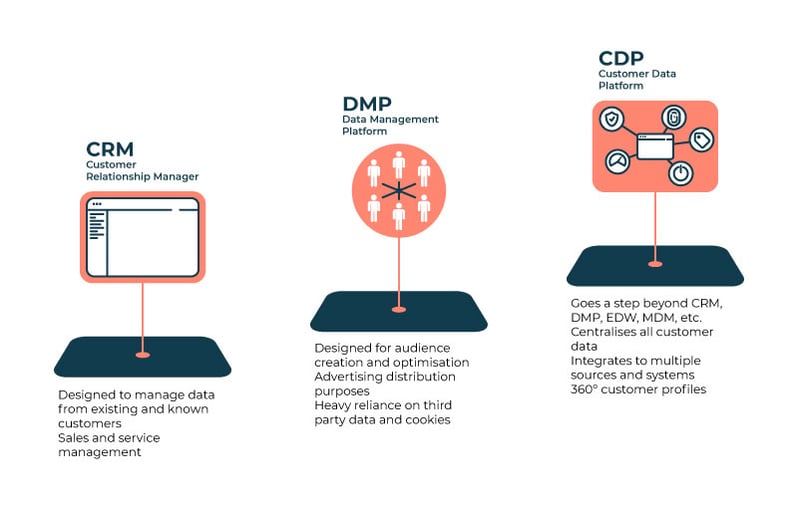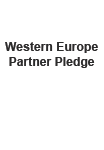In a context where more and more organisations are striving to be customer-centric and where customer expectations are constantly increasing, Customer Data Platform (CDP) has become an essential tool to carry out the transformation process, as well as to meet clients' new needs.

It is no secret that customer expectations are on the rise. In our article on marketing for millennials, we already discussed that consumers no longer only pay attention to the quality of products and services; they now equally value the quality of the customer experience and a brand's values.
The increasing expectations regarding customer experience are no coincidence. Big global technology players (Amazon, Google, Facebook, etc.) offer optimal experiences that have significantly elevated consumer expectations, especially in the digital environment. According to PwC, 59% of customers leave a company after multiple bad experiences and 17% after a single bad experience.
That is exactly why so many companies have realised that customer-centricity is now a requirement to stay in tune with the customer of today and tomorrow. According to Econsultancy, 58% of executive leaders state that customer-centricity is the most significant factor when it comes to developing a digital culture.
The urgency to accelerate change has only intensified because of the pandemic. According to McKinsey & Company, 2020 marked a turning point in the business world and the dramatic changes brought about by Covid-19 led companies to "pass a technological tipping point" that has changed marketing and operations forever.
All of this sets an ideal scenario for companies in which customers are the ones forcing the transformation processes. In other words, it is now the consumer who is forcing organisations to change.
Fortunately, there is a technology that can play a major role in accelerating all this: the Customer Data Platform (CDP).
Learn everything you need to know about Customer Data Platform (CDP) in our free e-book!
What is a Customer Data Platform (CDP)?
A Customer Data Platform (CDP) is a technological tool that belongs to the wide range of marketing technologies (martech). CDP Institute, one of the most relevant international CDP entities, defines it as follows: "It is software that creates a persistent and unified customer database that can be accessed by other systems". In other words, it is a pre-built system that unifies all customer data from all sources of origin and makes it available to other systems for the optimisation of customer experience strategies, marketing campaigns, etc.
David Raab, founder of CDP Institute, adds: "CDPs are software packages that help companies solve a huge and growing problem: the need for unified and accessible customer data. [...] A CDP provides the foundation a company will need in the upcoming years to meet customer expectations for exceptional personalised experiences."
In other words, a Customer Data Platform is a database that creates a single customer view by centralizing and tagging all customer data coming from any source or channel and enriches it for the generation of 360° customer profiles.
In order to create competitive customer experiences, know the customer in depth and offer personalised messages and content, companies need a 360º view of their customers: who they are, what are they interested in how they interact with each of the brand's touch points. In this sense, CDP has become a must, as it unifies all this information in a way that other customer data management platforms cannot and helps brands to produce personalised and consistent content and messages across all channels and touch points, both digital and face-to-face.
A CDP's main advantage is that, unlike other customer relationship management systems such as Customer Relationship Manager (CRM) or Data Management Platform (DMP); it can be integrated with pretty much any data source. In addition, it collects information from anonymous users, even those who have not made a purchase yet.
What is the difference between a CDP, a CRM and a DMP?

The main difference between a CRM (Customer Relationship Manager) and a CDP is that CRM focus on collecting transactional and sales data. That is, it provides information on the movements and transactions of our existing customers. In contrast, it does not contain information on the behaviour and movements of anonymous users who interact with our touch points without making a purchase. On the other hand, unlike a CDP, CRM systems can only be integrated with a limited number of systems and technologies.
Simply put, while CRM is designed to manage relationships with known customers and sales; a CDP provides a 360° view of existing customers, prospects and users.
On the other hand, Data Management Platforms (DMP) go a step further than CRM. DMPs are designed for the creation and optimisation of audiences and data is collected with the clear intention of distributing advertising content. In this sense, a DMP does not draw a complete customer profile, as it only unifies data related to advertising. Furthermore, Data Management Platforms rely heavily on third party data, especially third party cookies.
In short, a Customer Data Platform (CDP) is a system that goes one step beyond CRMs and DMPs. It is precisely designed to fill the gap in customer management left by Enterprise Data Warehouse, CRM systems, Data Management Platforms and Master Data Management. All these systems combined are not able to solve companies' business needs when it comes to managing customer relationships.
CDP, on the other hand, centralises all consumer data —customer meaning anyone who interacts with a brand's touch point— for the construction of 360º customer profiles.
Conclusion
Customer Data Platforms are an essential tool for those organisations that want to start their transformation towards a customer-centric company. This new approach to customer relationship management systems addresses the shortcomings of other customer data integration systems on the market and delivers a customer-centric, 360° customer view.
What is CDP's magic, what are its capabilities and how can it help us optimise customer strategies? Find out all this and much more in our e-book "CDP: A step closer to customer-centricity".




